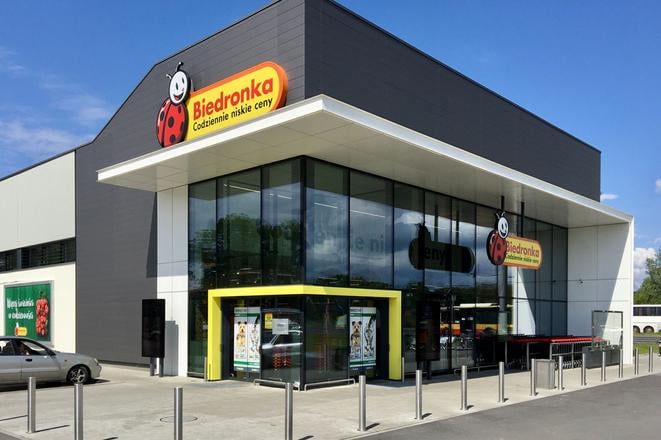The Slovak retail market is set for change in the near future as a slew of discount chains open stores in the country.
Just weeks after Dutch chain Action opened its first store in Slovakia, fast fashion outlet Primark became the main attraction for visitors at the newly extended Eurovea in Bratislava in May. Polish retailer HalfPrice will also be joining the Irish retailer at Eurovea soon.
However, the two firms are unlikely to be the last chains entering Slovakia in the near future with German retailer Woolworth, Austria’s Hofer and Polish discount grocer Biedronka also eyeing moves into the Slovak market.
“Slovakia and Poland have a similar shopping culture. Many Slovaks cross the border to Poland to shop at Biedronka, which is why we’re planning to invest in the country,” Pedro Soares dos Santos, board chairman of Portuguese firm Jerónimo Martins, which owns Biedronka, said, according to the Czech Primetime.cz website.
The discount chain, which is currently carrying out a detailed market analysis ahead of the planned move, has been operating on the Polish market for more than 28 years.
It has around 3,400 stores in Poland and recorded a profit of €1.5 billion in 2022 compared to €1.3 billion the year before. At €14.5 billion in 2021, the discount chain’s sales in Poland – a much larger market than Slovakia – are huge compared to others already established on the Slovak market.
The annual sales of Lidl, Tesco and Coop Jednota in Slovakia were each around €1.5 billion in Slovakia in 2021. However, size does not necessarily mean success in Slovakia, as the local market is relatively full and a number of players have already failed.
The Trend weekly highlighted that the expansion of the French supermarket chain Carrefour to Slovakia did not end well and Belgian company Delvita also pulled out.
First stores likely to be in northern Slovakia
Jerónimo Martins is currently seeking locations around Slovakia. The first stores are likely to open near the SlovakPolish border, interia.pl writes. But the first shop is not expected to open this year.
It is not clear if the planned stores in Slovakia will bear the Polish name or its Slovak version: ‘lienka’ – ‘ladybird’ in English. The company is carrying out market research and analyses.
However, some experts believe the arrival of Biedronka could produce some turbulence on what is already a very competitive market with Lidl, a very popular grocery discount store among Slovaks, most likely to come under pressure because of its similar low-cost concept.
Data from business analysis company FinStat showed that Lidl registered record margins in Slovakia in 2021, turning more than seven cents of every euro of sales into profit.
The Kaufland and Tesco retail chains had slightly lower margins at around five percent, with the remaining competition not even reaching half that level, the Sme daily wrote.
Experts say that the arrival of Biedronka would be a good thing for the market, arguing that greater competition between grocery chains will be of more help lowering food prices than any state intervention.
“Any increase in the competitive environment is the right tool to fight inflation – it can objectively push prices down,” Martin Krajčovič, chairman of the Slovak Alliance of Modern Trade, told Trend. “We consider it the best tool to reduce prices without state regulation.”
Biedronka’s expansion in Slovakia is not expected to be easy though, not least because there is less available and suitable land to build stores on compared to 2004 when Lidl started.
Discounters usually launch operations in a new market with several stores at once to make distribution worthwhile. Lidl, for example, had 14 stores when it launched in Slovakia.
However, Biedronka’s Polish warehouse distribution may help it in northern Slovakia, noted Sme.
Woolworth to be next?
Another lowcost retail chain considering entering the Slovak market is Woolworth, according to the Hospodárske Noviny daily.
Robert Le Veneur, marketing expert and CEO of RobertNemec.com, an advertising agency based in Prague, described the Woolworth range as being close to Pepco and Action.
“It’s a very cheap chain that primarily offers clothing,” he told the Hospodárske Noviny daily. “But you can always find other types of goods there, such as household or super-cheap drugstore items.”
Asked why Woolworth is experiencing a resurgence, he says that similar discounters thrive when the economy struggles.
“The moment the economy fares badly, all of society moves down a notch or two in terms of where they shop and what they buy,” Le Veneur told the daily.
This opens up a lot of space for these discounters, as a large part of the middle class heads to their stores, he added.
“Maybe they sensed the opportunity in the market and said to themselves when else should we expand if not now?” Le Veneur said. He added that during an economic boom, middle class shoppers may steer away from discount stores, but in challenging economic times, they will happily shop in them.
“If discounters teach [these customers] to shop there, they will get a quick return on their investment,” he said.
Old plans dusted off
Meanwhile, Hofer has not ruled out entering the Slovak market. More than a decade ago the chain had plans to open stores in a number of cities in Slovakia, but shelved them after the financial crisis, the tvnoviny.sk website reported.
“As far as entering new markets is concerned, we are following current developments very closely and we regularly analyse and evaluate possible expansion opportunities,” company spokesperson Cathleen Völkel, told the website.



 The first Biedronka stores are likely to open near the Slovak-Polish border. (source: Unsplash)
The first Biedronka stores are likely to open near the Slovak-Polish border. (source: Unsplash)